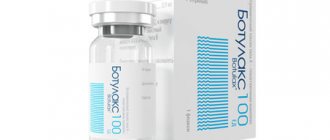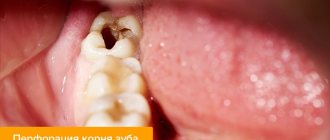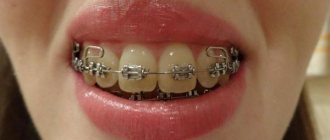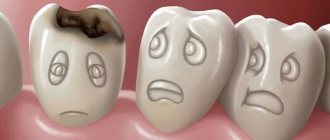It’s amazing how much a beautiful smile with straight, white teeth influences a person’s appearance and relaxedness. Of course, not everyone can boast of such luxury - some have naturally not very white teeth, others were unable to maintain the integrity of their dentition. And in this case, lumineers to the rescue - they can be installed at any age (we are, of course, talking only about adults), and the price of the issue is not comparable to the cost of other methods, especially when you consider how long the overlays will last.
What are Lumineers? These are very thin ceramic plates used as onlays on teeth. Their thickness is almost less than that of contact lenses, and after installation they are not felt at all.
Lumineers are often compared to veneers. Is there a difference between them? Yes, and it is quite significant - lumineers are thinner and therefore do not require preliminary grinding of the teeth. But the minimum thickness should not confuse you - in fact, lumineers are very durable, as they are made from a special composite material with the addition of crystals, making it resistant to external factors - food, exposure to a toothbrush, and so on.
What is teeth lamination
Some believe that teeth lamination is some kind of new unique technology. But in fact, such a name in dentistry is nothing more than another marketing ploy that attracts the attention of more patients. Lamination here hides the service of covering enamel with special materials (composite), as well as various overlays made of ceramics, zirconium dioxide, and ceramic composite.
Teeth lamination is the coating of enamel with special materials.
If you see names such as “veneering”, “laminates”, “lamination” in dental advertising, then know that we are talking about the same thing. During the procedure, specialists will cover the outer, that is, the frontal area of your teeth, with a thin layer of material or the thinnest plates, the main purpose of which is to hide all external imperfections in the smile area.
Today, not only teeth are laminated, but also nails, eyelashes, hair, and, of course, documents. In fact, the concept of “lamination” comes from the Latin lamina, which translates as “plate”. It is implied that an additional layer is applied to some surface, which makes it more beautiful, stronger, more perfect, and protects it from external influences.
Advantages
- High strength and durability (a high-quality product will last up to 20 years).
- of dental lamination compares favorably with the installation of lumineers.
- Ceramics retains color and beauty even when exposed to tobacco smoke, coffee, and juices.
- Natural light refraction makes laminates indistinguishable from natural enamel.
- The hermetic junction of hard tissues and ceramics guarantees the protection of the tooth from the effects of negative factors.
- Installation is quick and comfortable for the patient.
What are the indications for the procedure?
The purpose of the procedure is primarily to improve the external condition of the teeth located in the frontal area of the smile. This is not a therapeutic event, but a cosmetic or restoration one. That is, it is designed to bring your smile closer to the ideal, eliminate an unsightly shade of enamel, grayness or yellowness, minor cracks and chips, interdental spaces, hide old fillings, slight curvature or irregular shape of teeth. Lamination is also recommended for patients who have not received the desired and long-term results from whitening procedures, or for whom whitening is simply contraindicated: with severe forms of fluorosis and hypoplasia, with “tetracycline” teeth, wedge-shaped defects and erosion.
The procedure is recommended for gray and yellow teeth
Laminates on teeth perform not only an aesthetic, but also a protective function. They reduce hyperesthesia or increased sensitivity of tissues, as they serve as a kind of barrier to food, acids and sugars that we eat with food. They also make the enamel less susceptible to cold and hot, prevent the penetration of bacteria, the development of caries and destructive processes.
Contraindications
Veneers have certain contraindications:
- severe destruction of the front teeth;
- numerous fillings on the frontal incisors;
- bite problems;
- Bruxism: grinding your teeth at night will lead to rapid failure of the linings.
If the patient is not going to carefully monitor oral hygiene, then it is better for him to also refrain from such a procedure. Previously, the removed pulp was an absolute contraindication, but now this issue can be resolved individually.
How is the procedure performed?
In fact, there are several lamination methods: direct and indirect.
Direct method
The procedure takes very little time, and you only need to visit the doctor once. At the appointment, the specialist carries out all the manipulations directly in the patient’s mouth: layer by layer, he applies the composite material to the restored area and exposes it to an ultraviolet lamp, then covers everything with a fixing varnish, grinds and polishes.
The undeniable advantages of the method are that it saves time and also money for the patient. In addition, materials applied to the enamel can be removed or adjusted at any time in the dental office.
You can restore your smile using composite materials
This lamination option is considered the most budget-friendly, but, unfortunately, it is very short-lived. The fact is that composites do not have the necessary shine and transparency that natural enamel has. In addition, over time they become dull and stained by food, even with good oral hygiene. To maintain the original beauty of composites, you need to visit a doctor at least once every 3-4 months for grinding and polishing.
Indirect method
Let's talk about how indirect teeth lamination is done. At the first appointment, the specialist will take impressions of the jaws, as the laminates will be created according to your individual parameters in a dental laboratory. And only during the second visit to the clinic, which usually takes place 2-3 weeks after taking impressions, the doctor actually performs lamination, that is, using special glue, he fixes thin plates on the teeth.
The most popular types of laminates: composite veneers1 (can be created by direct and indirect methods), classic veneers (from zirconium dioxide and pressed ceramics E.Max, Empress), the thinnest original American lumineers (DUO-PCH and Cerinate), ultraneers (the Russian manufacturer positions they are similar to lumineers, although they are less durable and not as thin).
This method is quite expensive, and you don’t get the result right away, since you have to wait for the onlays to be made in the laboratory. But in the end, the quality of work, as a rule, exceeds all expectations, that is, the patient receives an ideal snow-white smile, which, with proper care, will delight for at least 7-10 years. At the same time, the materials used to create indirect laminates completely imitate the appearance and shine of natural teeth, and are not stained by products and retain their beauty throughout their entire service life.
Look at the result after teeth lamination in the photo below. What happened before and what happened after is a big difference. Indeed, the appearance of a smile is radically transformed. Do you agree?
The photo shows teeth before and after installation of veneers
Advantages and disadvantages
Compared to other reconstruction technologies, the procedure has a number of advantages:
- Tissues are injured less than when fixing veneers;
- Long service life;
- Painless;
- With semi-direct or indirect methods, you can predict the result, and also check whether the shade is suitable before starting work. The doctor places the plate on the tooth to see how natural the color looks.
The disadvantages include the high cost of the service and the fact that the enamel is still damaged.
Do I need to grind off the enamel before laminating?
Various sites on the Internet are replete with information that the enamel in composite restorations, as well as when installing indirect laminates (created in the laboratory), does not need to be ground. But that's not true. When installing any onlay, as well as before laminating teeth, the top layer of enamel is slightly filed off. What is it for:
- to give the restored smile a natural look: layers of material that the doctor applies to the teeth, or laboratory onlays, although thin, still make the crown more voluminous and convex. To remove excess volume, the doctor has to act on the enamel,
- provide reliable fixation to the materials: enamel is smooth and shiny by nature. If you leave it in its natural form, then even when using special adhesives there is still a risk that the fastening will be reliable. It is to ensure better adhesion that doctors slightly file the enamel, making its surface slightly rough,
- hide imperfections: if the tooth is slightly crooked or has a dark color, and immediately put a thin overlay on top of it without any manipulation, then there will be no point in this, since the restoration will look unnatural.
Before installing microprostheses, a specialist grinds the teeth
Content:
- Teeth lamination procedure
- Who is suitable for lamination?
- Contraindications to lamination
- Preliminary assessment of the result
- Preparation for lamination
- Lamination techniques
- How to increase service life
When the color of the enamel darkens, dentists offer different aesthetic techniques, but preference should be given to the most non-traumatic ones.
It is important to preserve as much healthy dental tissue as possible to prolong the life of the restored unit. For many people, teeth lamination is a real salvation. This is a safe and effective procedure to improve the aesthetics of the dentition. It will help transform your smile if classic whitening techniques are prohibited for some reason.
Is it necessary to undergo professional hygiene before lamination?
The procedure is required. Firstly, it will remove plaque and deposits that can make the enamel structure uneven. Secondly, such a measure will help to identify pathologies hidden from the doctor’s eyes and eliminate them. For example, caries may hide under a thick layer of plaque at the initial stage of the disease, in the form of a chalky spot. Thirdly, professional hygiene will eliminate bacteria and normalize the microflora of the oral cavity, which means that the infection will not get under the laminate, which will allow you to enjoy the result of lamination without risk to oral health for as long as possible.
“I smoked for a long time, but recently I quit completely. Before that, I tried to whiten the enamel using chemical procedures, but the positive result lasted for a maximum of six months. And now the doctor suggested lamination. It seemed to me that the procedure was more natural and natural, something like whitening. There is no such harmful effect, and now the result, I hope, will be longer.”
Kisa, review from baby.ru
Before installing onlays, be sure to carry out professional oral hygiene
It is important to undergo professional hygiene not only before lamination, but also after it (1-2 times a year). Modern devices allow this procedure to be performed in a gentle and as gentle manner as possible, so your restorations will remain safe and sound.
Read in detail about how professional cleaning takes place and what stages it consists of in the feature article on the website.
Is it possible to laminate only one tooth?
Theoretically, this can and is allowed. But doctors recommend lamination of not just one, but preferably all teeth located in the smile zone, at least 8 upper ones. This measure will help to achieve naturalness and the ideal shade throughout the entire row in the visible area. Otherwise, the restored teeth may differ from those on which the procedure was not performed.
A lot in this matter depends on the type of lining you choose. Thus, it is possible to restore 1-2 units of a row with composite materials and veneers, but none of the professional specialists will simply supply you with original lumineers for 1 tooth. Lumineers are distinguished by their ideal whiteness, to which it would be simply unrealistic to match adjacent teeth with other restoration methods.
In some cases, it is possible to restore one tooth
Bracket systems
However, veneers are not able to fully replace braces. They correct only minor defects and imperfections.
Linings are not able to adhere to:
- abnormal bite,
- large trema and diastema,
- slow process of teething and curvature of dental groups.
These complex diseases require orthodontic treatment, which involves the use of braces. Only they will make the smile line correct and straighten the teeth that are in a checkerboard pattern. Braces can be installed at any age. But before installing them, it is necessary to treat the teeth and gums, as well as the bones of the dentofacial apparatus.
Braces are special brackets through which a thin arch made of nickel or titanium is threaded. The arch is able to “remember” shapes and gradually tightens and aligns the dentition. Treatment with braces lasts approximately two years, and then a retention period begins, when the brace systems are replaced with special plates of a simpler and more comfortable design.
How much does the service cost?
Teeth lamination is a procedure, the price of which directly depends on the type of veneer you choose. If this is just a direct composite restoration, then the cost of transforming one element of a row starts from 8,000 rubles. You need to pay more for the installation of veneers and ultra-veneers: from ceramics - from 25 thousand rubles, from ceramic composite - from 35 thousand rubles, from zirconium dioxide - from 40 thousand rubles.
The cost of original lumineers, created directly in a US laboratory, starts from 70 thousand rubles.
Notice
: Undefined variable: post_id in
/home/c/ch75405/public_html/wp-content/themes/UltraSmile/single-item.php
on line
45 Notice
: Undefined variable: full in
/home/c/ch75405/public_html/wp-content /themes/UltraSmile/single-item.php
on line
46
Rate this article:
( 2 ratings, average: 5.00 out of 5)
dental restoration
- Biryukova R.R. Aesthetic restoration of the frontal group of teeth // Bulletin of medical Internet conferences. – 2022.
Expert “It is advisable to carry out lamination only if the person does not have significant pathologies in the smile area and the structure of the teeth being restored is not disturbed. For example, there are no artificial crowns or large fillings, deep caries, or malocclusions – in particular, deep and straight ones. The procedure is also contraindicated for bruxism and increased enamel abrasion. Otherwise, the visual effect that the patient is striving for will not be achieved, and the restoration itself will be short-lived.” Orthopedist Chorny Stanislav Vladimirovich
Consulting specialist
Orlova Elena Vladimirovna
Doctor rating: 9.5 out of 10 (2) Specialization: Dentist-therapist Experience: 33 years
Sections we recommend
On these pages you will find more information about teeth lamination and smile restoration methods:
- Consultation with an orthopedist
- Microprosthetics
- Aesthetic dental restoration
Literature:
- Yudina N. A. “Systematization of microprostheses of the anterior group of teeth and justification for the choice of aesthetic design: veneers, laminates, ultraneers, lumineers or composites?” // Modern Dentistry No. 2, 2012
- The official website of Cerinate Smile Design Studio, a manufacturer of lumineers.
Comments
How to brush teeth with laminates?
Mari K. (03.11.2020 at 13:08) Reply to comment
- Oral hygiene procedures in this case are carried out standardly, using a brush and paste, as well as an irrigator and rinse. The only thing you need to pay attention to is that the brush should have soft bristles, and the paste should not contain abrasive particles, as this can lead to microcracks and scratches on the surface of the artificial material.
Editorial staff of the portal UltraSmile.ru (06.11.2020 at 09:24) Reply to comment
If I have crowns and they were not made perfectly white, because... The enamel of my teeth is yellow by nature. Is it possible to laminate a certain shade? To match the color of the crowns.
Julia (11/20/2020 at 4:00 pm) Reply to comment
Hello! I have been thinking about this procedure for a long time... Please tell me, do I understand correctly that my tooth is being ground down, and then it will not be possible to remove the veneering? So it’s no longer possible to return to natural teeth?
Nastya Li (11/20/2020 at 05:52 pm) Reply to comment
As we age and our teeth lose their shape, is lamination a good option for old age?
Quiet (11/20/2020 at 6:09 pm) Reply to comment
Hello!!! My teeth are naturally yellowish-gray. I didn't bleach them with anything. Since I work as a teacher and consider my appearance unaesthetic due to my teeth, I came to the conclusion that I need lamination. After reading about teeth lamination, many questions arose. Is this harmful to the enamel? What should I do if I need dental sanitation or treatment after lamination? Help me please
Adele (11/20/2020 at 7:19 pm) Reply to comment
Six months ago I installed veneers on my teeth. Yesterday I noticed that one of them seemed to have moved a little away from the tooth, what should I do?
Alla (11/30/2020 at 4:22 pm) Reply to comment
- Contact your doctor immediately so that a specialist can glue the pad back on, if possible, or make a new one. It is impossible to leave everything as is, since in such a situation there is a possibility of damaging the tooth itself and the gums around it, and bacteria and pieces of food get clogged under the detached lining, which can lead to an inflammatory process.
Editorial staff of the portal UltraSmile.ru (04.12.2020 at 10:02) Reply to comment











